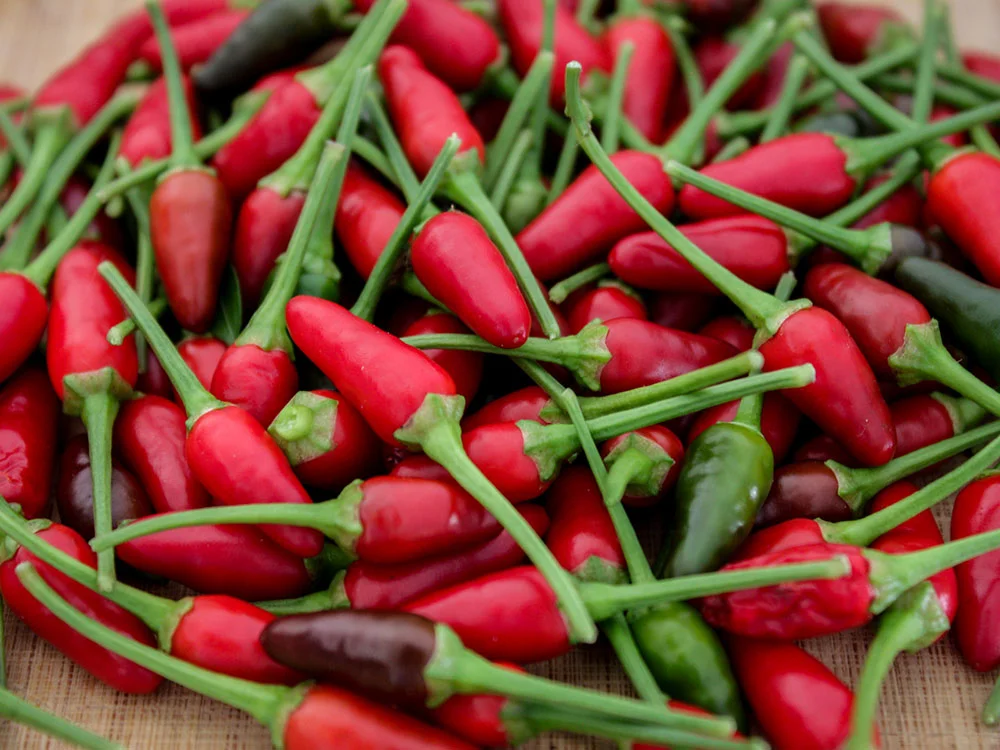Vegetable Gardening
When to Harvest Bird’s Eye Chillies: A Comprehensive Guide
Bird’s eye chillies are a favorite among spicy food enthusiasts. But how do you know when it’s the perfect time to harvest Bird’s Eye Chillies?
Knowing When to Harvest Bird’s Eye Chillies
Bird’s eye chillies, sometimes referred to as Thai Chilis, Peri Peri, Piri Piri, African Devil, and Malawi Bird’s Eye Chili , pack a fiery punch in a small package. These vibrant chillies are popular in Southeast Asian cuisine, offering a piquant flavor to dishes.
Once you know how to grow Bird’s Eye peppers, you need to know the key to getting the best taste and heat out of them. In this post, we will delve into understanding the optimal time to pick bird’s eye chillies from your garden.
Recognize the Color Change
One of the easiest ways to determine if a bird’s eye chilli is ripe for picking is by its color. A young bird’s eye chilli starts off green. When it matures, it transitions to a bright red hue.
Although you can harvest and use green chillies if you’re after a slightly milder flavor, for the complete spicy kick, wait until they turn a deep red.
Check the Size
Bird’s eye chillies are typically small, about a 1/2 inch in length. When they reach this size and are firm to touch, they’re likely mature and ready to be plucked. But remember, the size can vary based on the variety and growing conditions.
It’s always a good idea to know the expected size of your specific variant.
Test for Firmness Before Harvesting Bird’s Eye Chillies
A mature bird’s eye chilli should be taut and firm. If you give it a gentle squeeze, it shouldn’t feel soft or mushy. A soft chilli might indicate that it’s overripe or has been affected by a pest or disease.
Monitor the Growing Days
Generally, bird’s eye chillies take between 60 to 90 days to mature from the time you transplant them. By marking the date of transplantation on your calendar, you can get a rough estimate of when your chillies might be ready for harvest.
However, this is just a guideline. Rely on the other signs, color, size, and firmness, to confirm their readiness.
Sample One for Taste
Tasting a chilli is, of course, the ultimate test of its readiness. If you’re brave enough, pick one off the plant, give it a rinse, and take a small bite. If it offers that fiery kick you’re after, it’s time to start harvesting.

Bird’s Eye Pepper Seeds: Sizzling Flavor to Heat Up Your Recipes
Best Practice to Harvest Bird’s Eye Chillies
Use the Right Technique
When you decide it’s harvest time, don’t just tug on the chilli. The branches are fragile, this could damage both the fruit and the plant. Instead, use a pair of sharp scissors or pruning shears. Cut the stem above the fruit, leaving a small portion of the stem attached to the chilli.
Best Time of Day to Harvest Bird’s Eye Chillies
Just like most vegetables, it’s best to harvest bird’s eye chillies during the cooler parts of the day – early morning or late afternoon. This ensures they retain their freshness, especially if you don’t plan to use them immediately.
Continual Harvesting
The beauty of bird’s eye chilli plants is that they continually produce fruits over the growing season. So, once you start harvesting, keep a regular check on the plant. New chillies will develop and mature, ready to spice up your dishes.
Important: Monitor the Plant’s Health
Healthy plants produce quality chillies. Ensure your plant gets adequate water, sunlight, and nutrients throughout its growth period. If the leaves begin yellowing or the plant appears stressed, it may be a sign of under or over-watering, or even a pest infestation.
Addressing these issues promptly ensures a plentiful and spicy harvest.
Storing After Harvest
If you don’t plan to use your harvested chillies immediately, store them in a cool, dry place. You can also freeze them, dehydrate the peppers, or use them to make spicy oils and sauces. If you opted to dehydrate the peppers, at a later date you can grind some up and make hot sauce from the pepper powder.
Conclusion
Growing bird’s eye chillies at home is both fun and rewarding, especially when you get to spice up your meals with homegrown produce. Knowing when to harvest them ensures you enjoy the fullest flavor and fieriest heat these little powerhouses can offer.
So, pay close attention to the signs and get ready for a spicy treat when the time is right. Happy harvesting!
FAQ: Harvesting Bird’s Eye Chillies
What to do with bird’s eye chili peppers?
Bird’s eye chili peppers add a fiery kick to dishes. They can be used fresh in salads, cooked in stir-fries, dried for longer shelf life, or transformed into spicy sauces and pastes.
Do bird’s eye chillies turn red?
Yes, bird’s eye chillies start off green and mature to a bright red color, indicating they’re ripe and have reached their full heat potential.
Can you eat green bird’s eye chillies?
Absolutely! While they’re milder than their red counterparts, green bird’s eye chillies can be eaten and offer a unique flavor, adding zest to various dishes.
Should you pick chillies as soon as they turn red?
It’s a good practice to harvest chillies when they turn red as this indicates full maturity. Picking them at this stage ensures maximum flavor and spiciness.
Are birds eye chillies hotter than jalapenos?
Yes, bird’s eye chillies are generally hotter than jalapenos. While both can vary in heat, bird’s eye chillies typically have a higher Scoville rating, indicating more spiciness.






